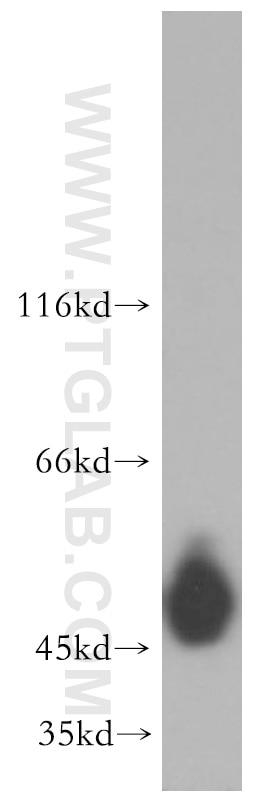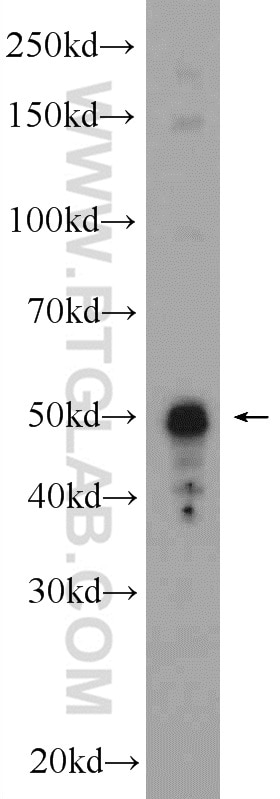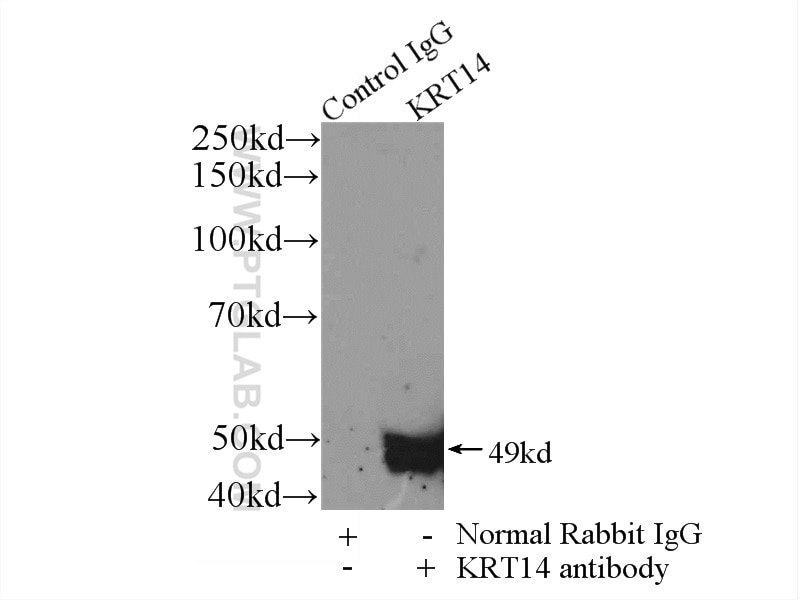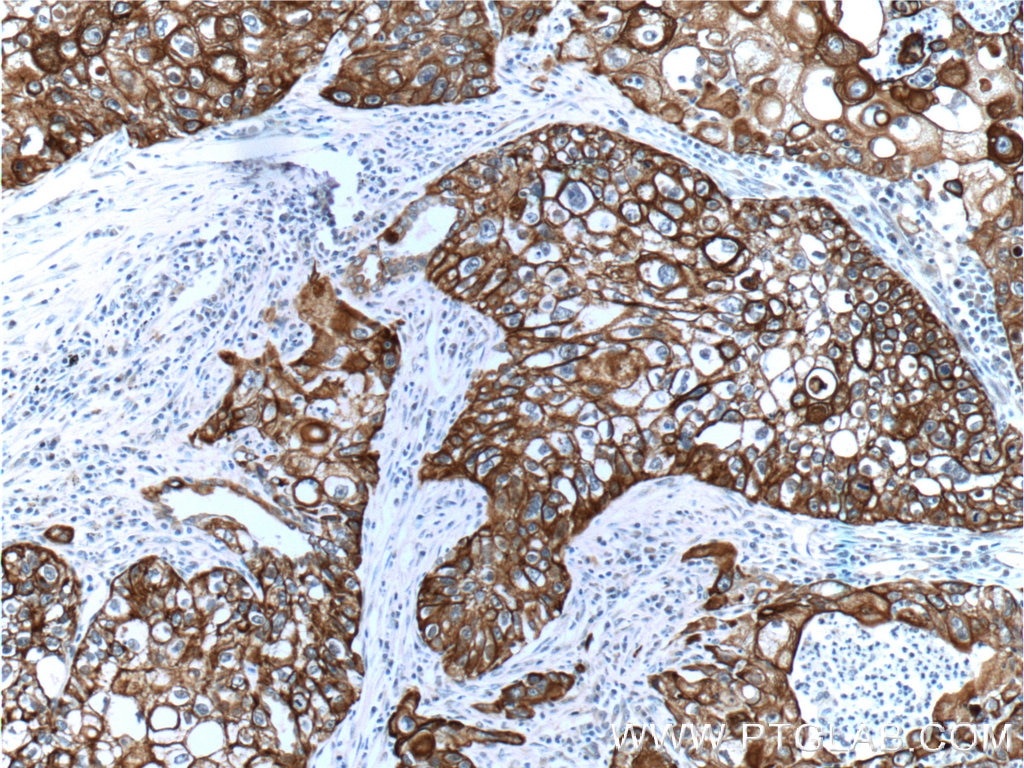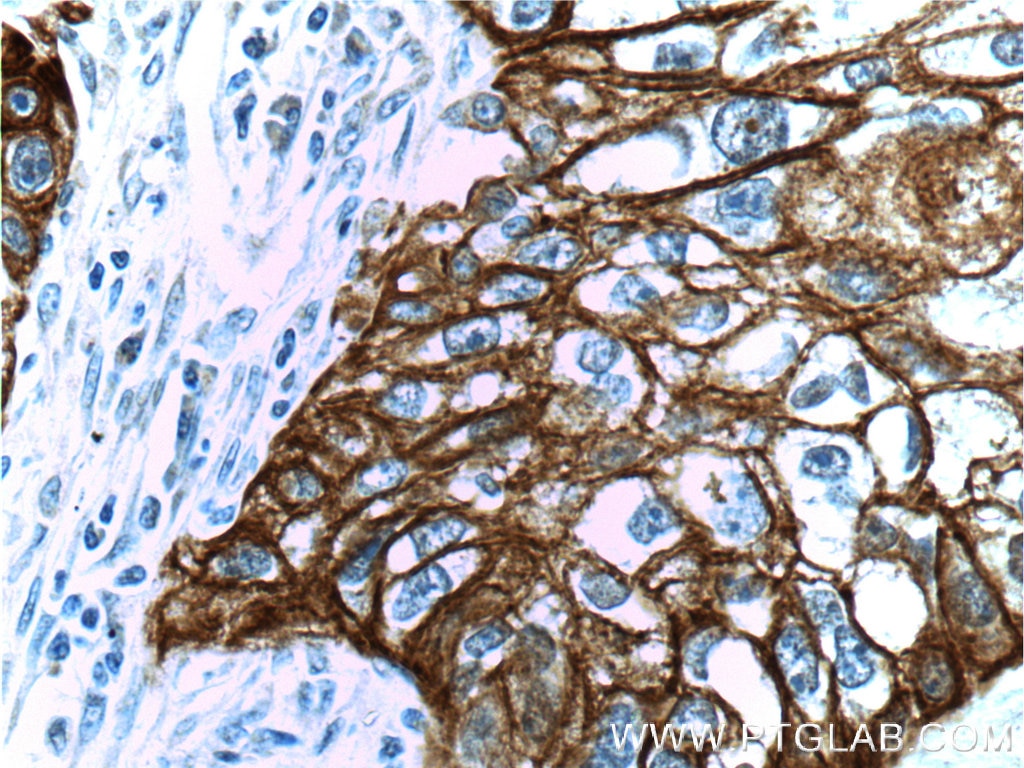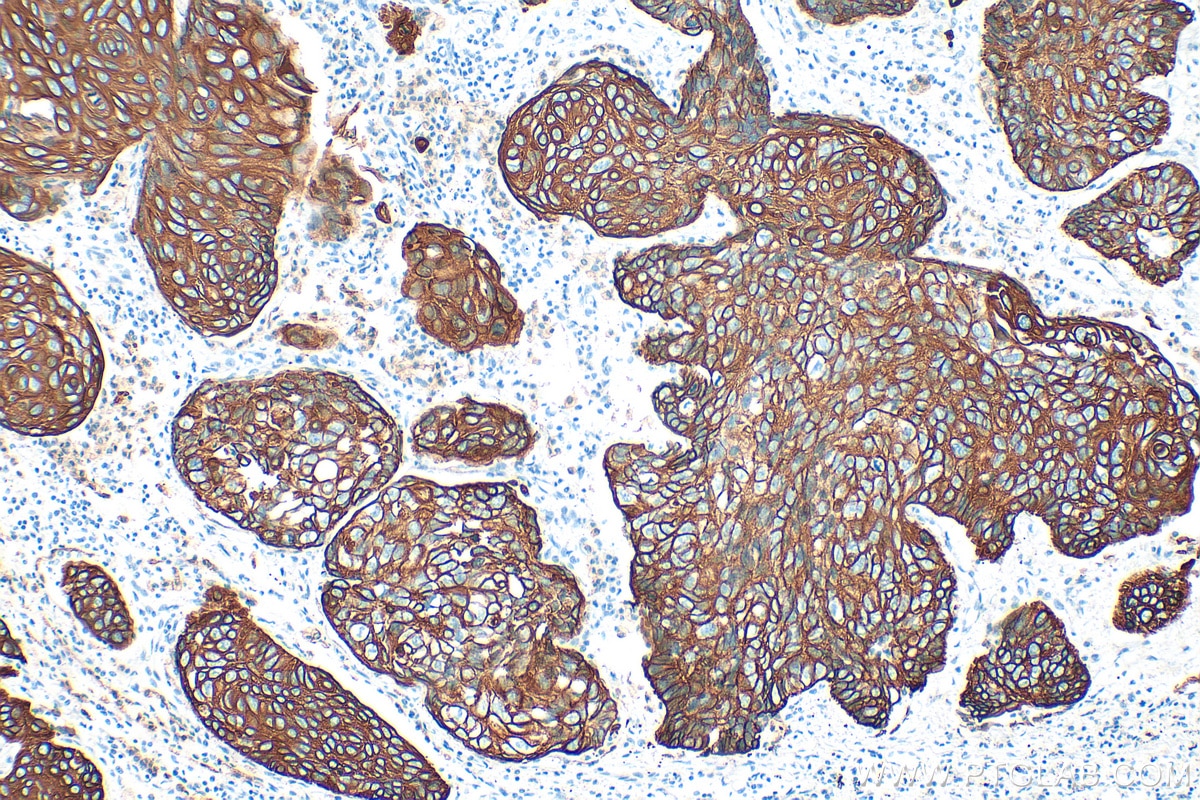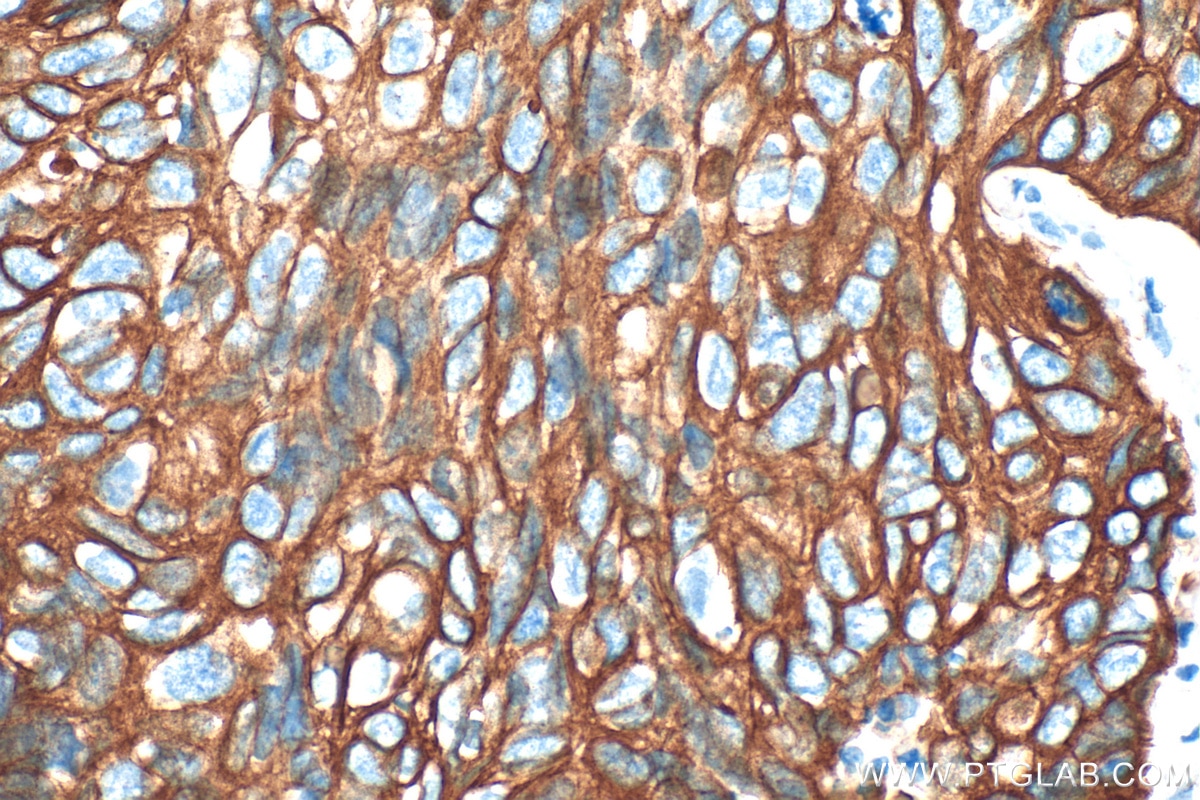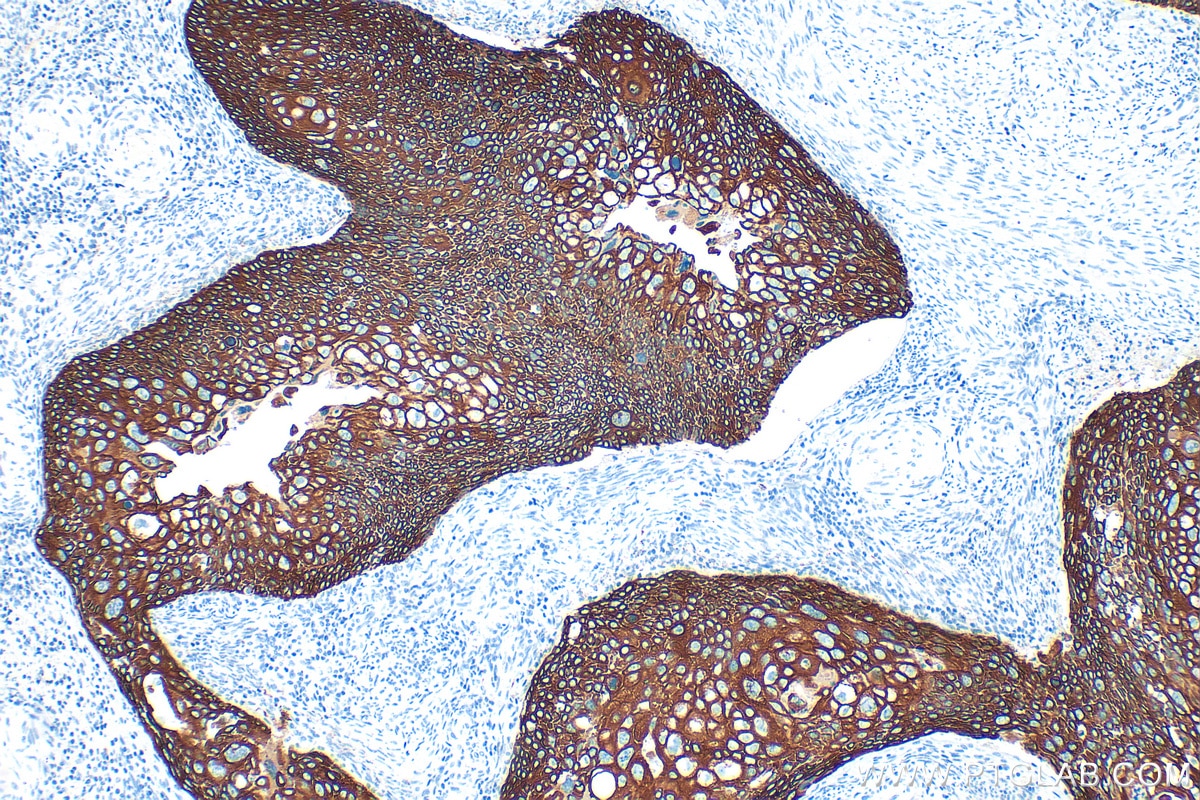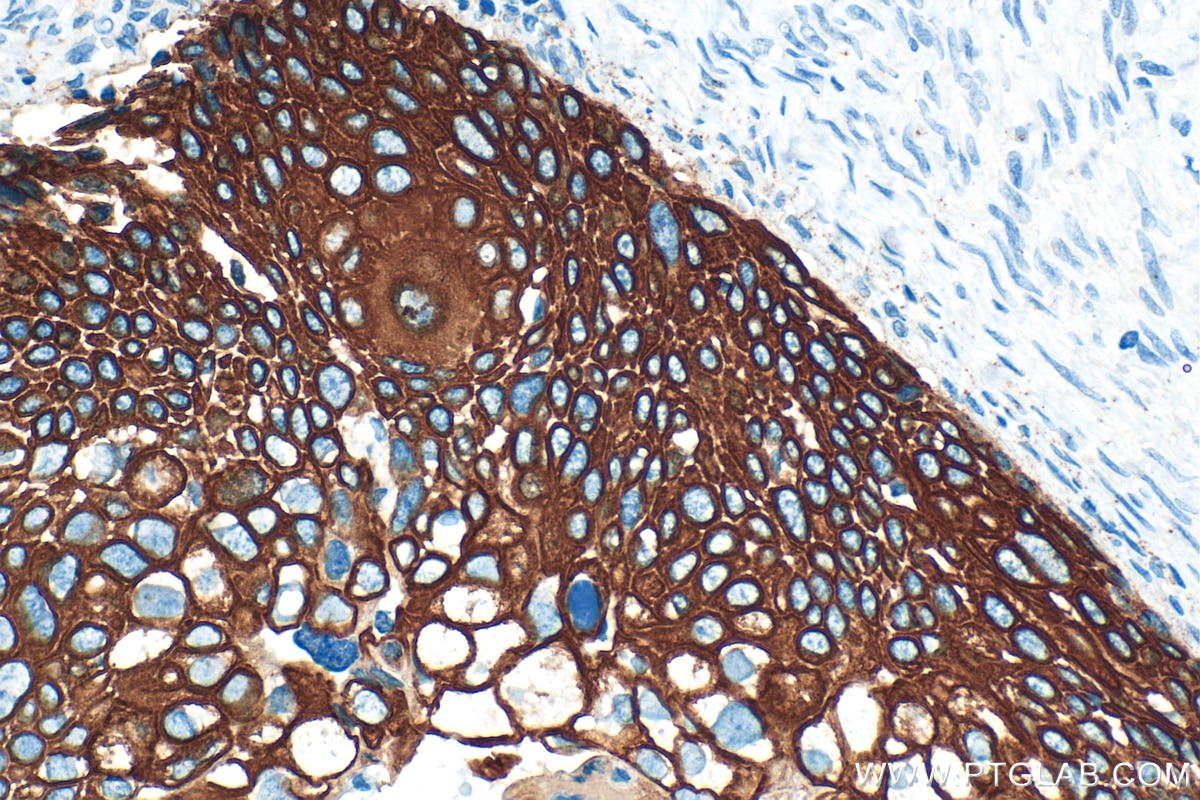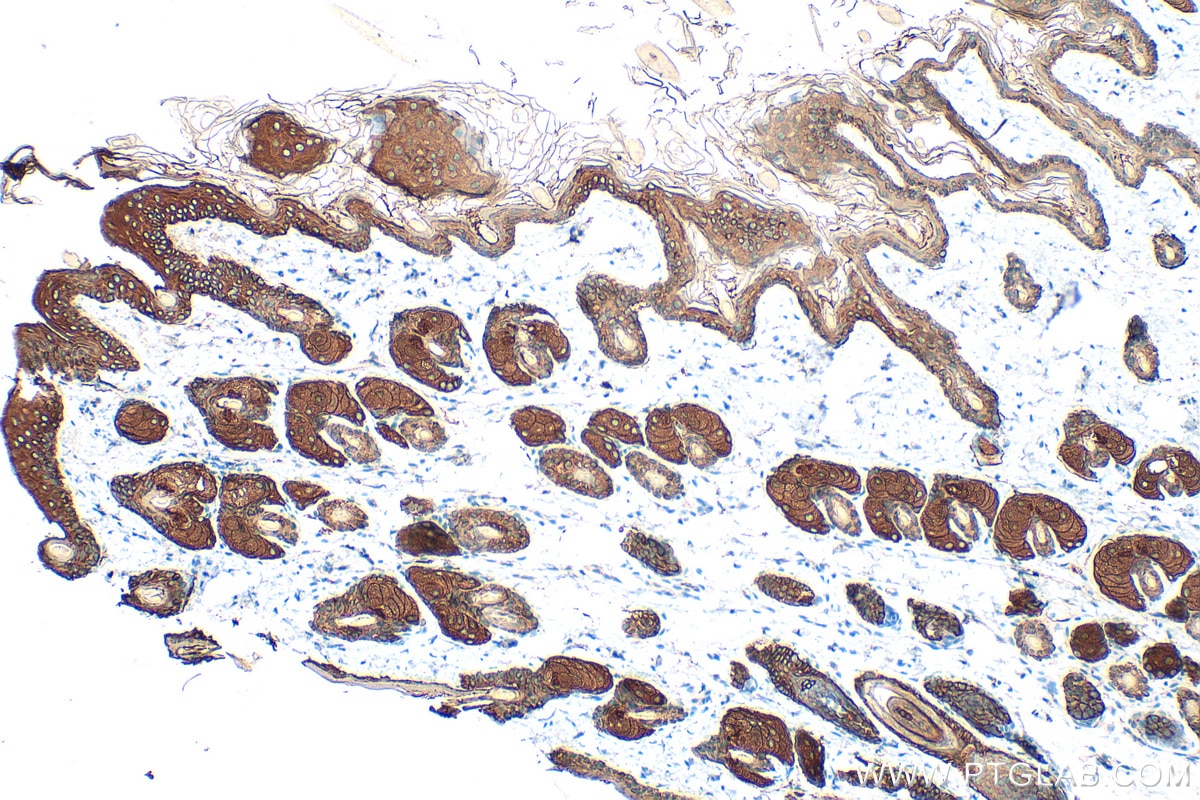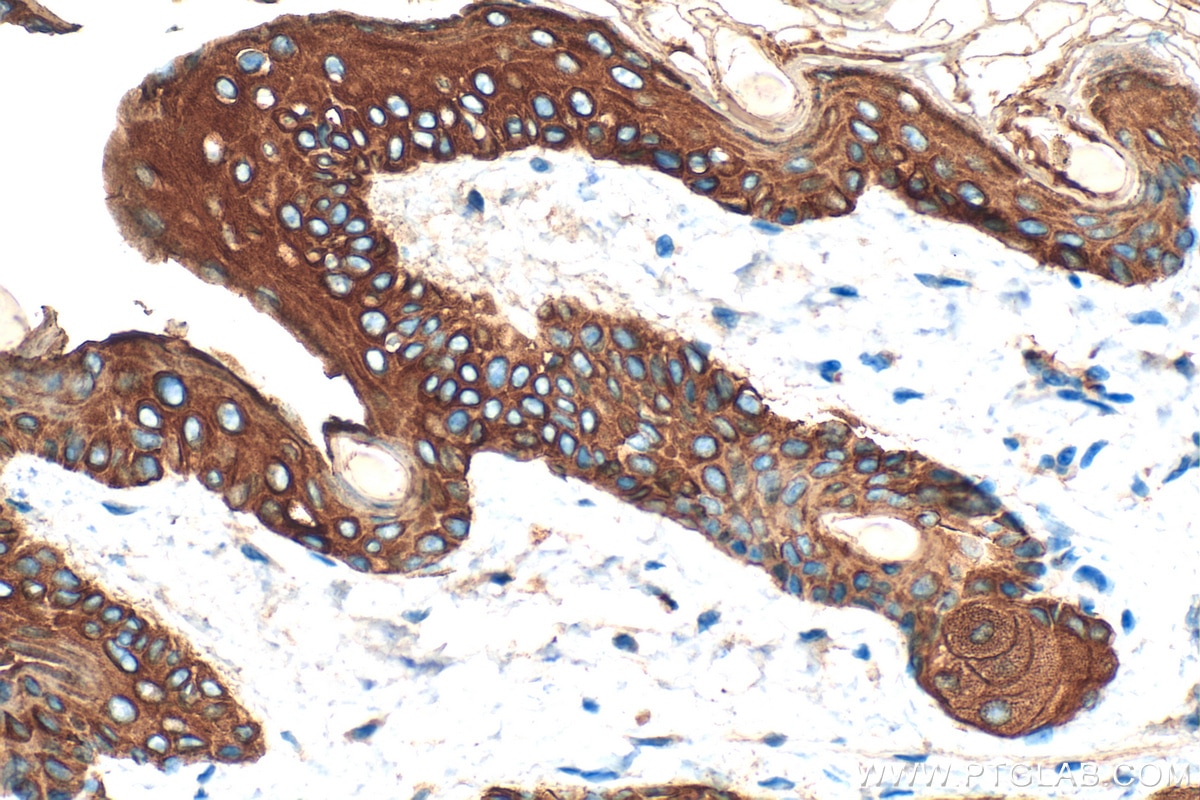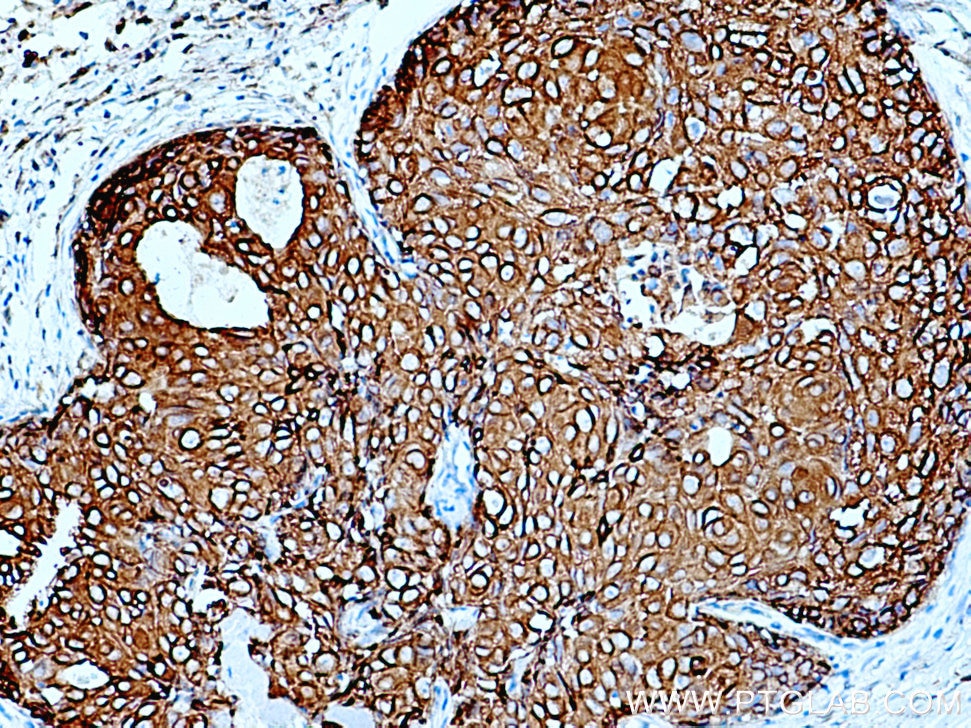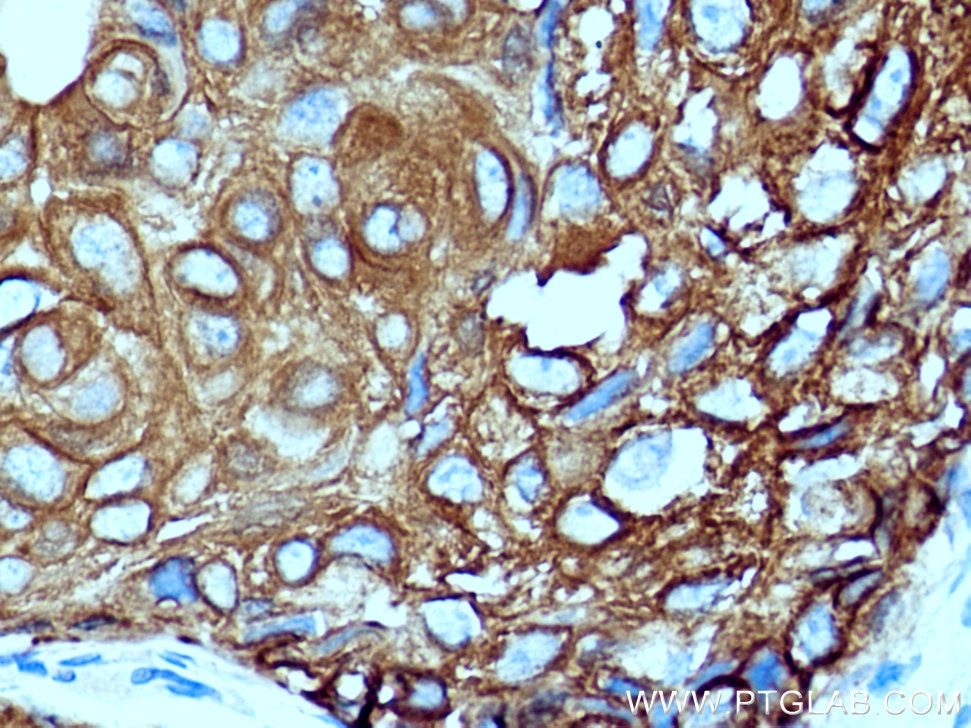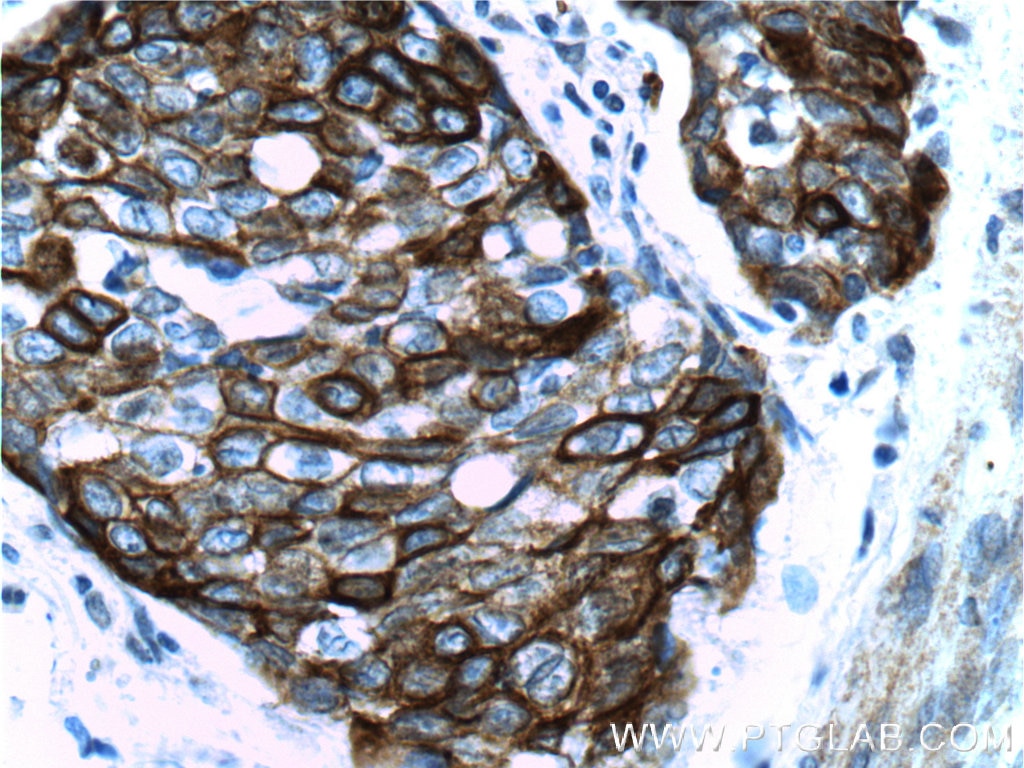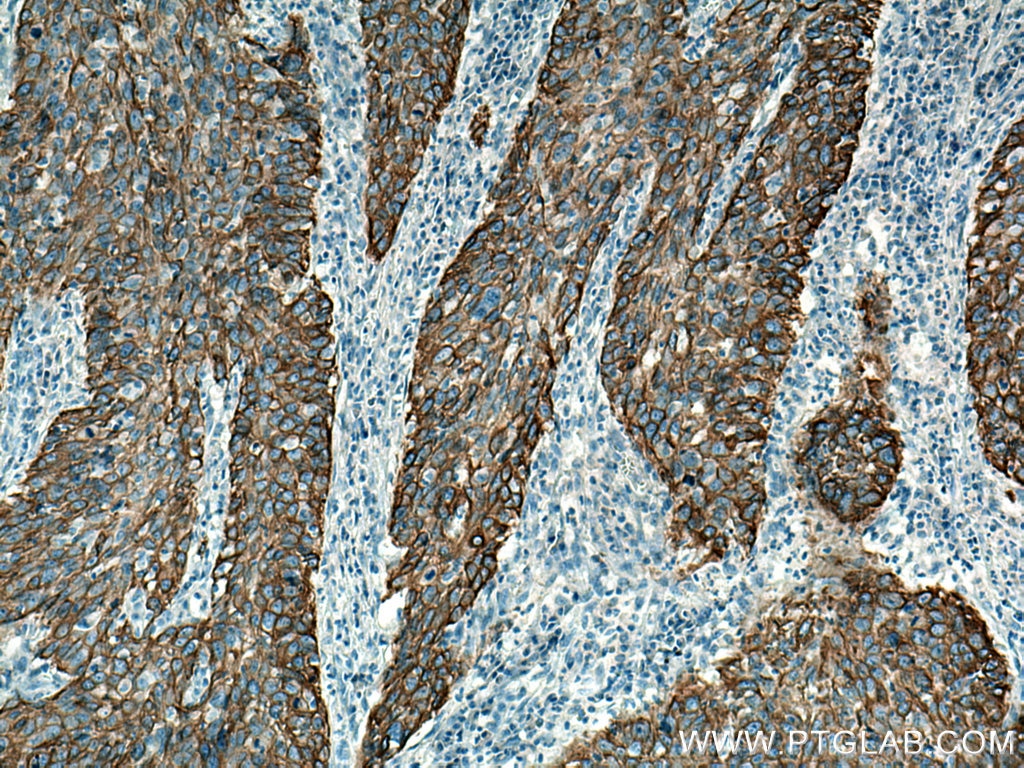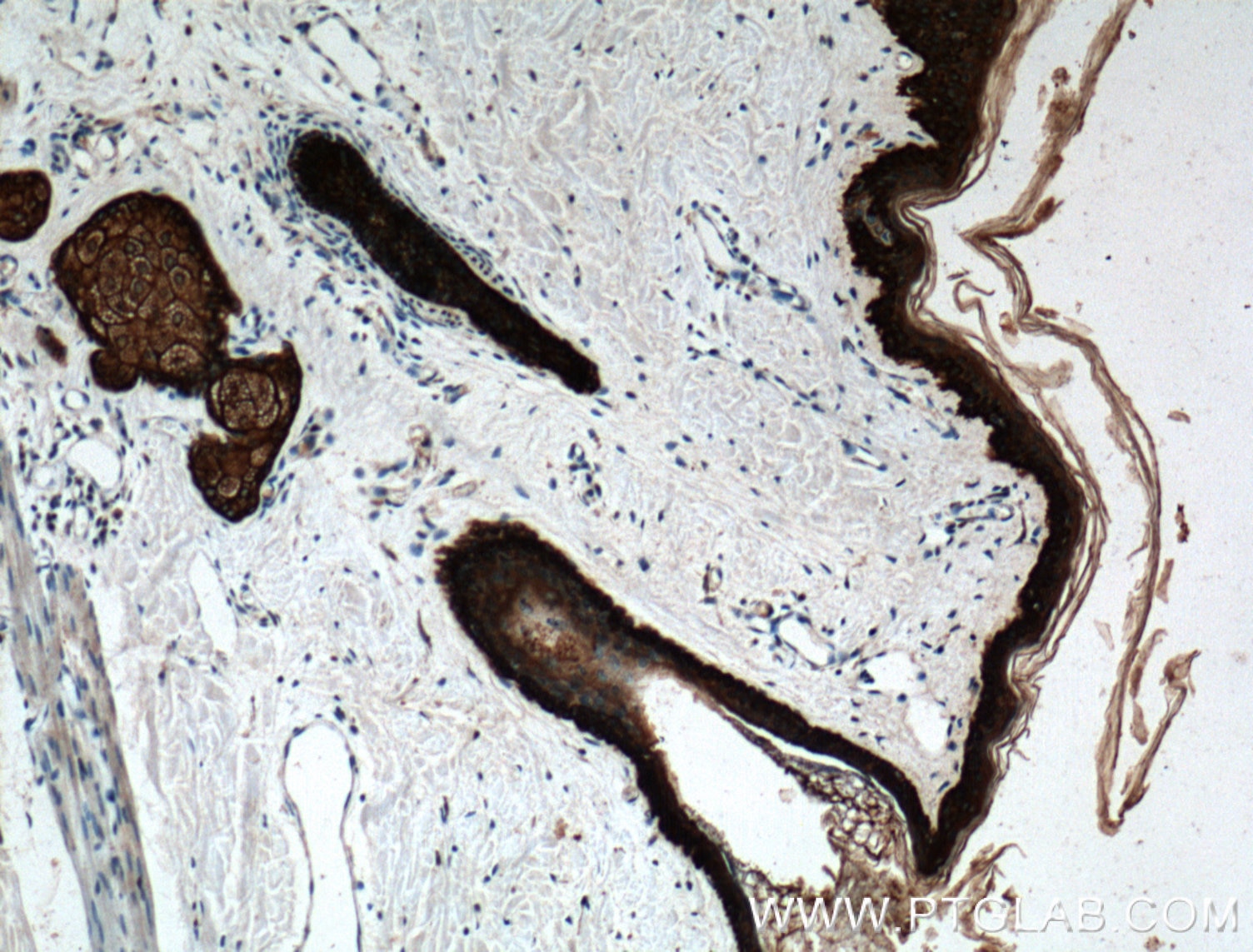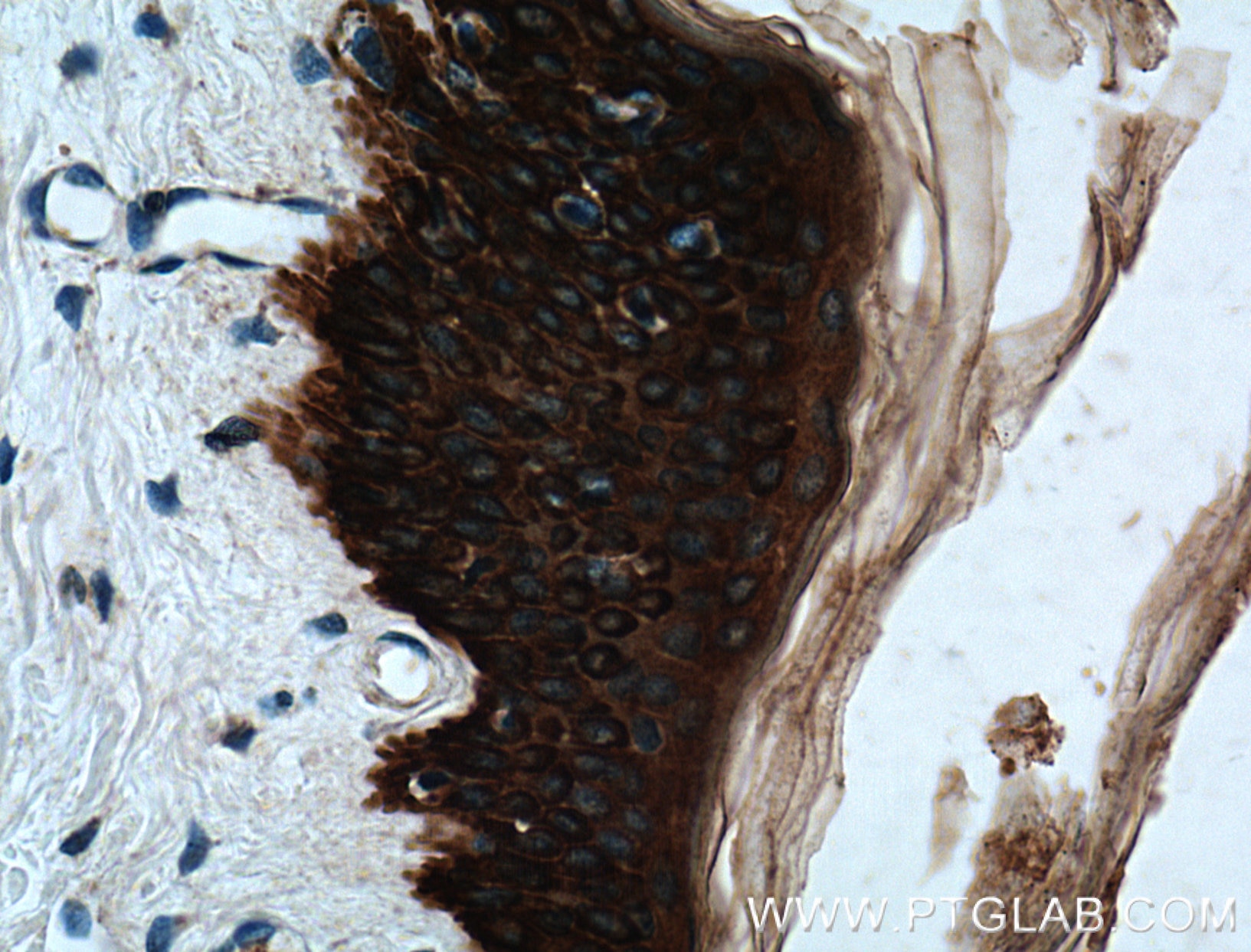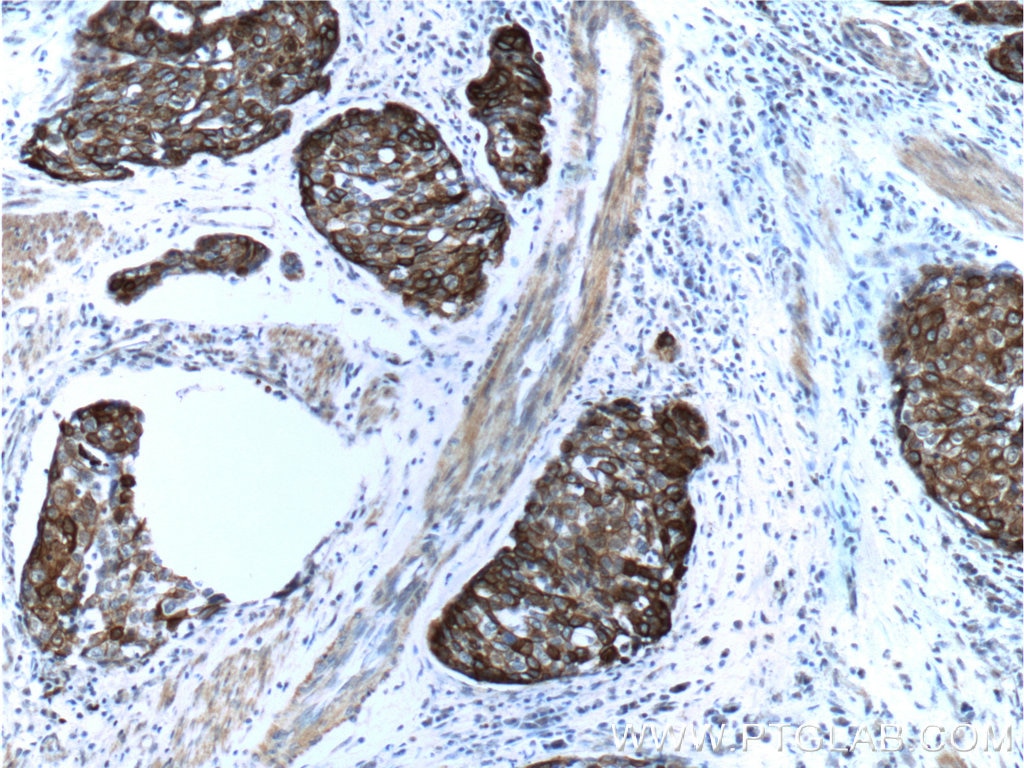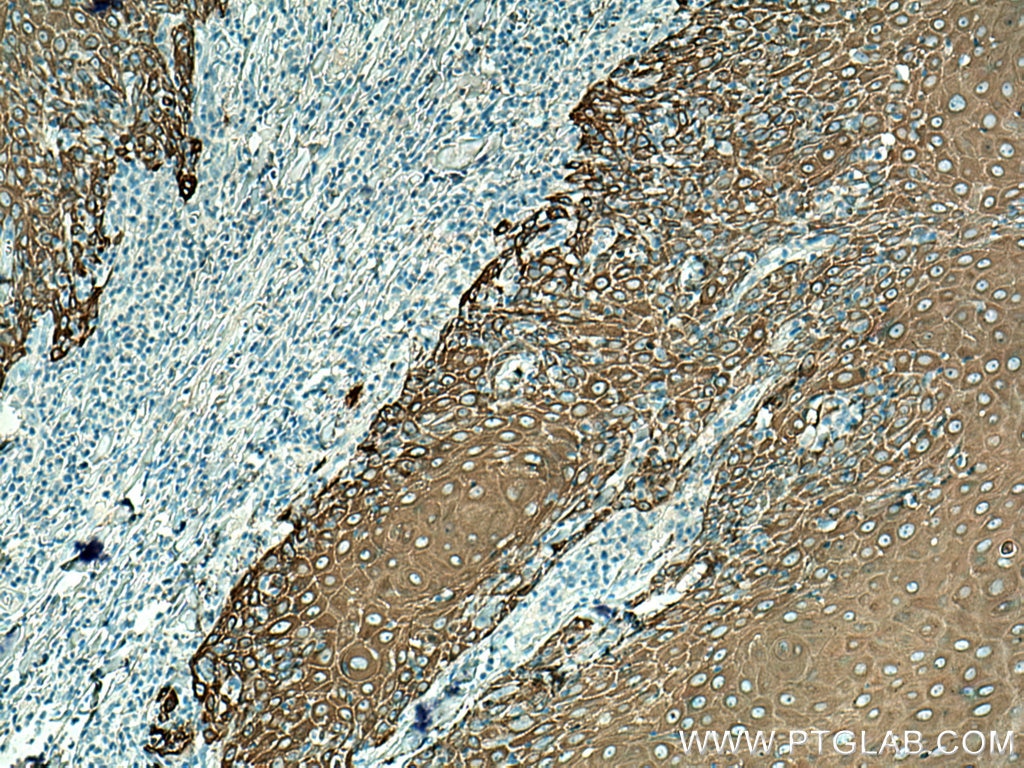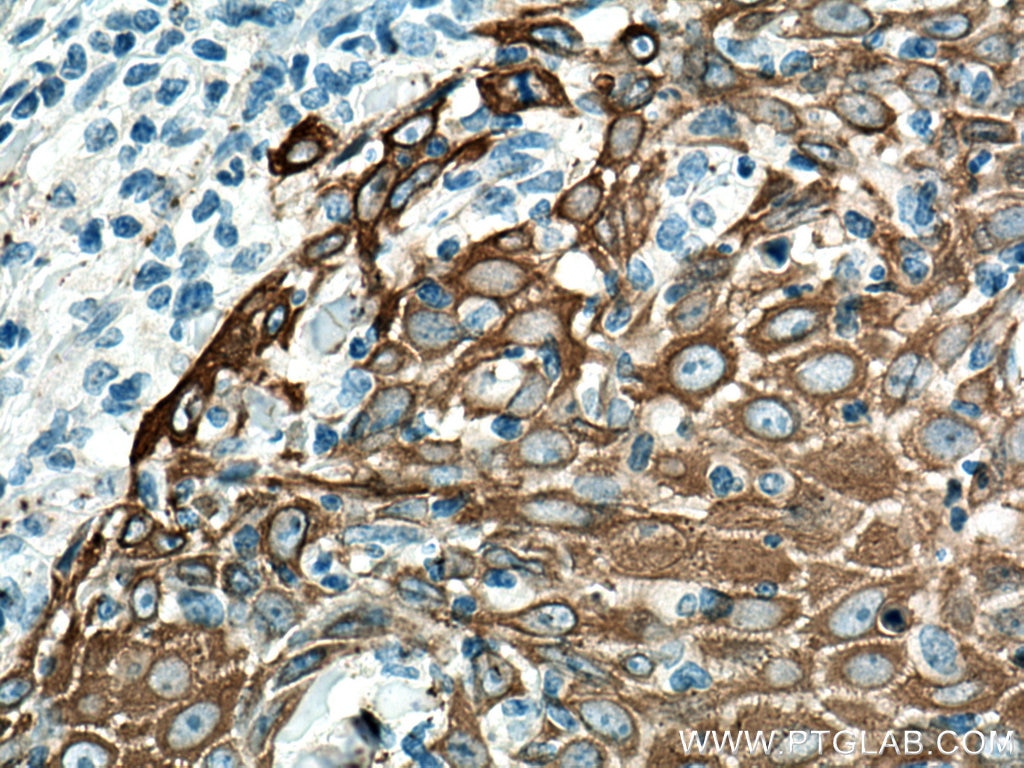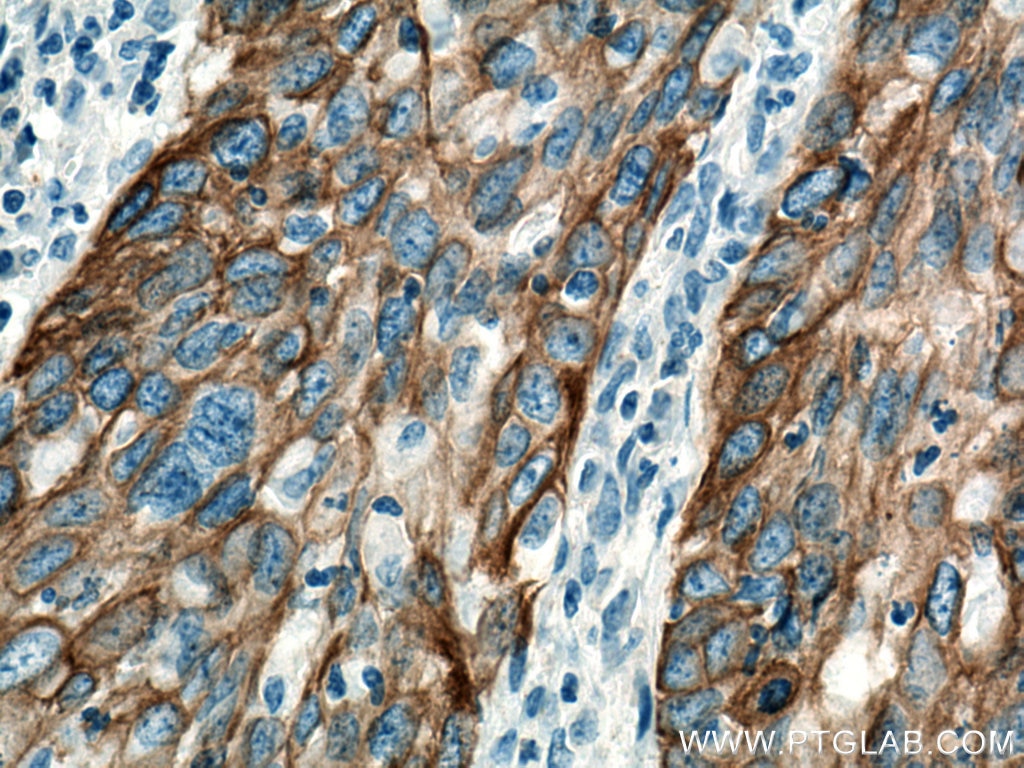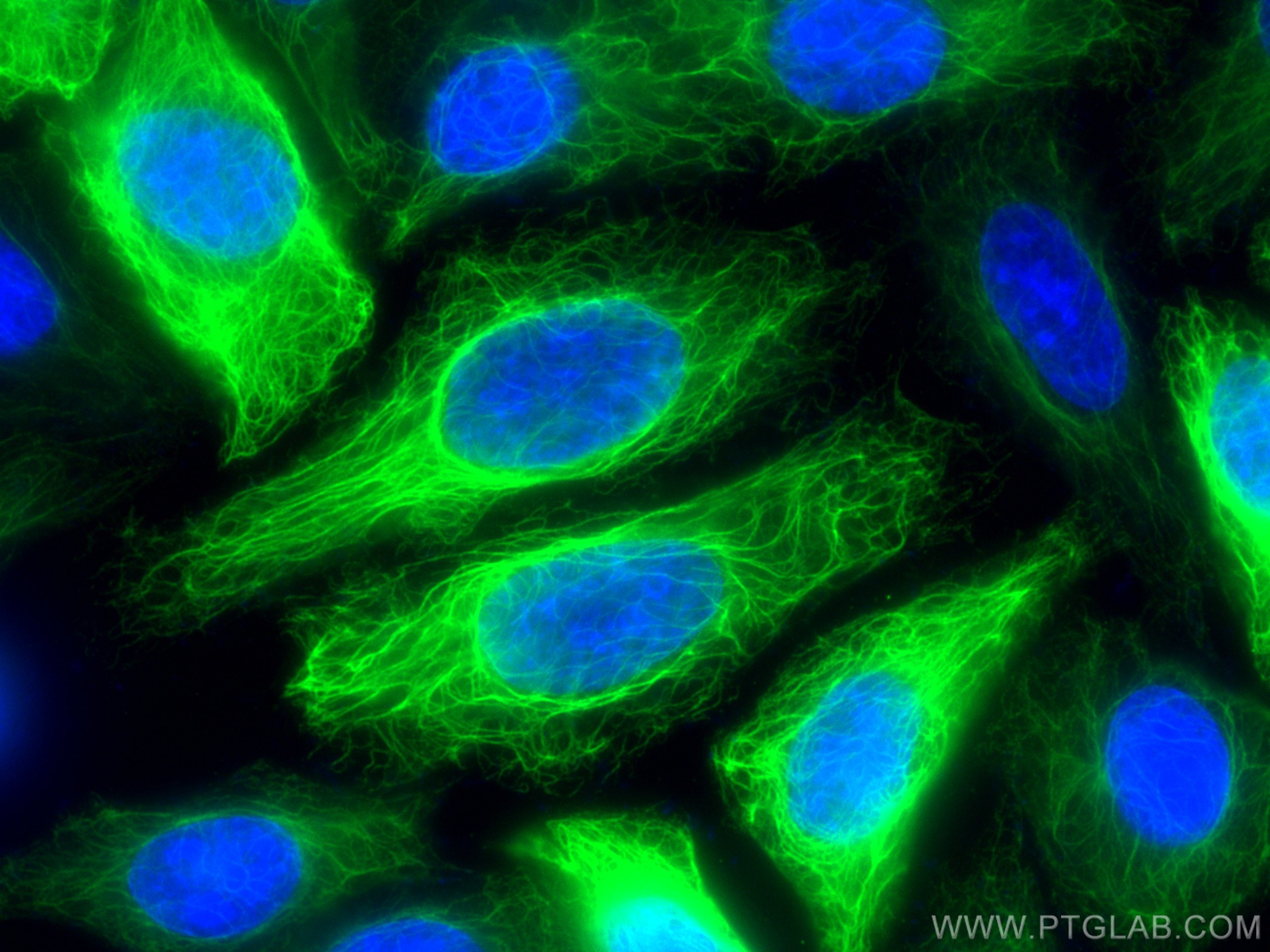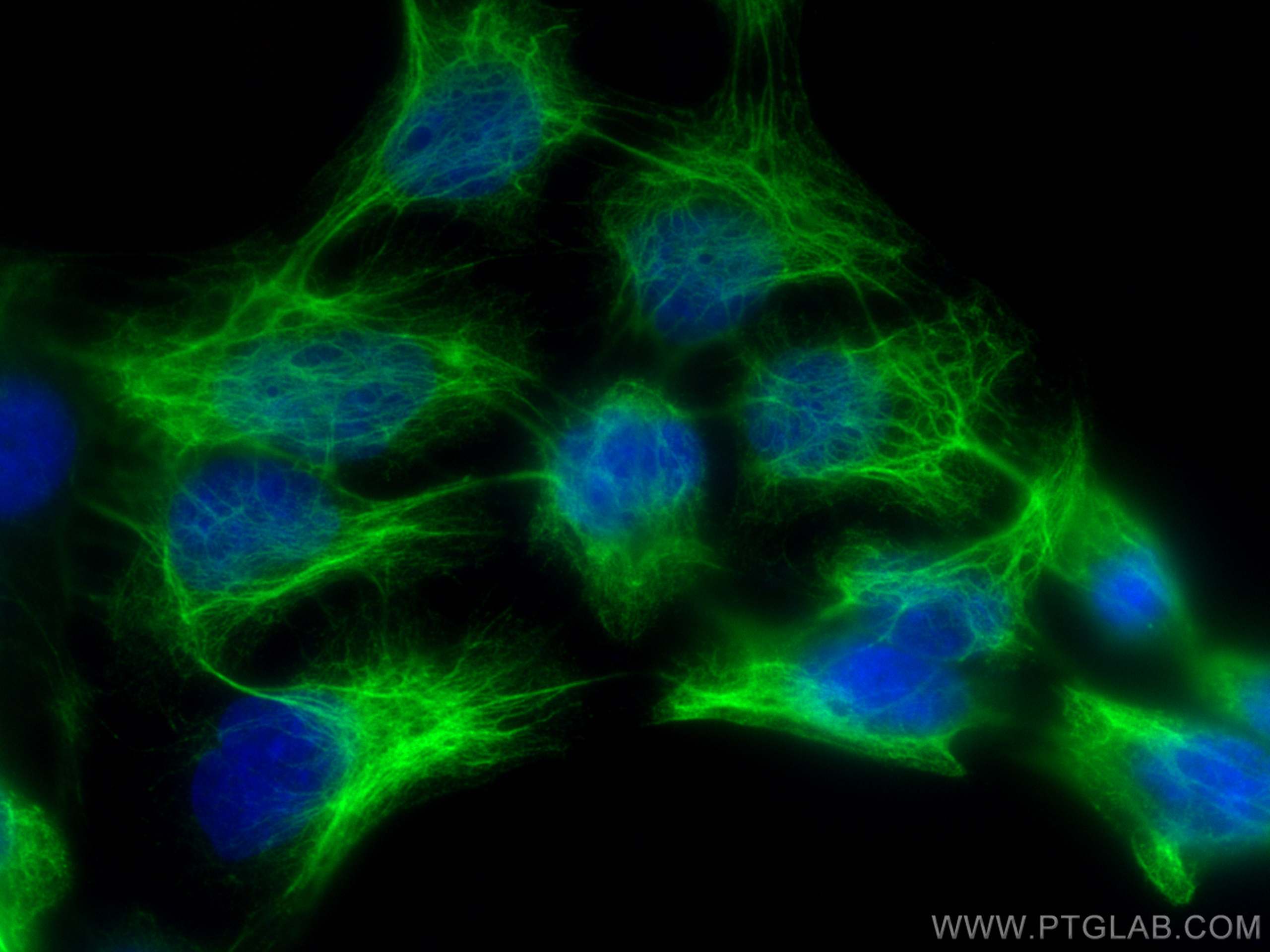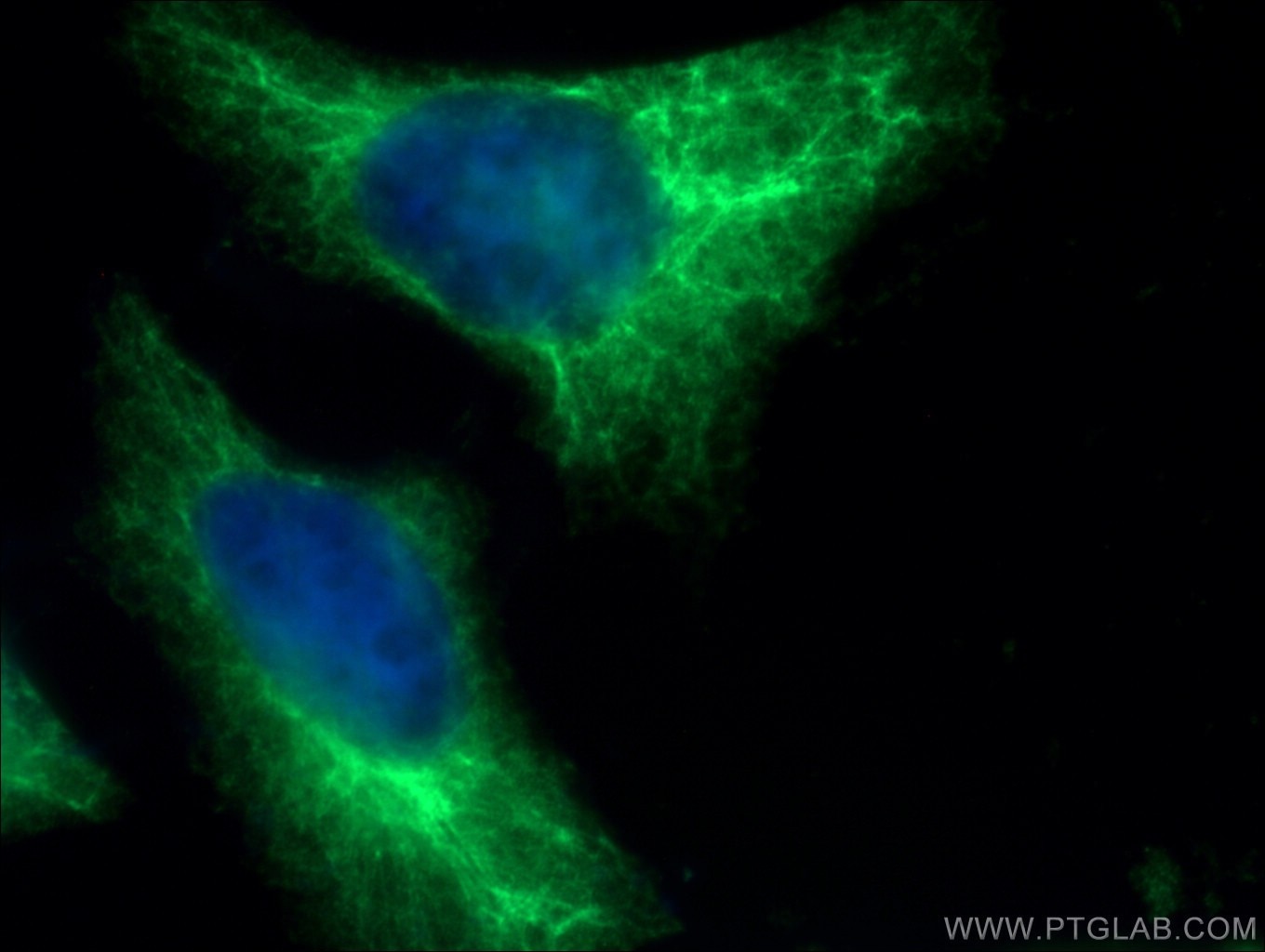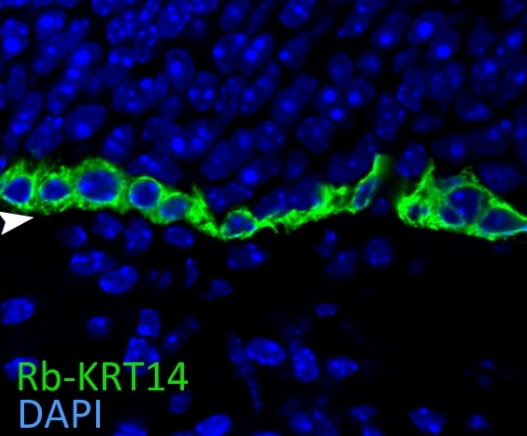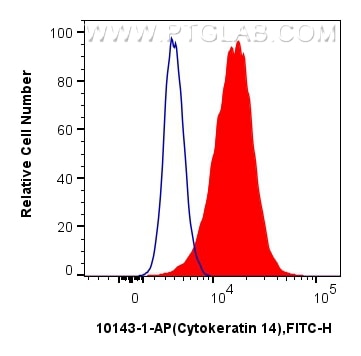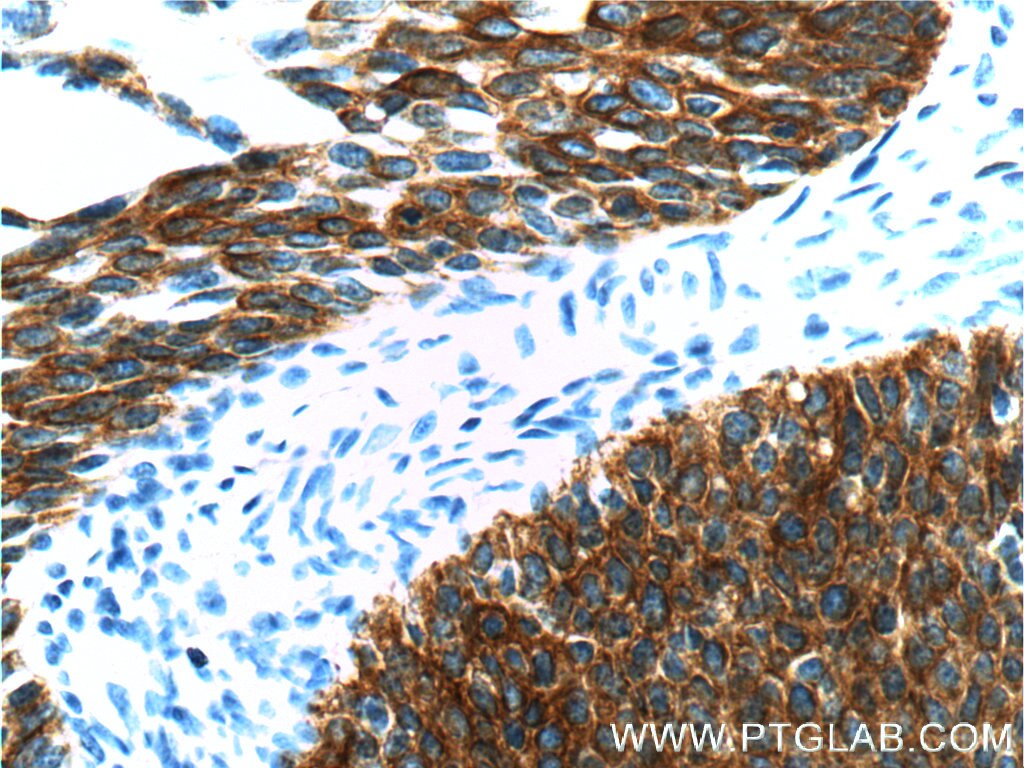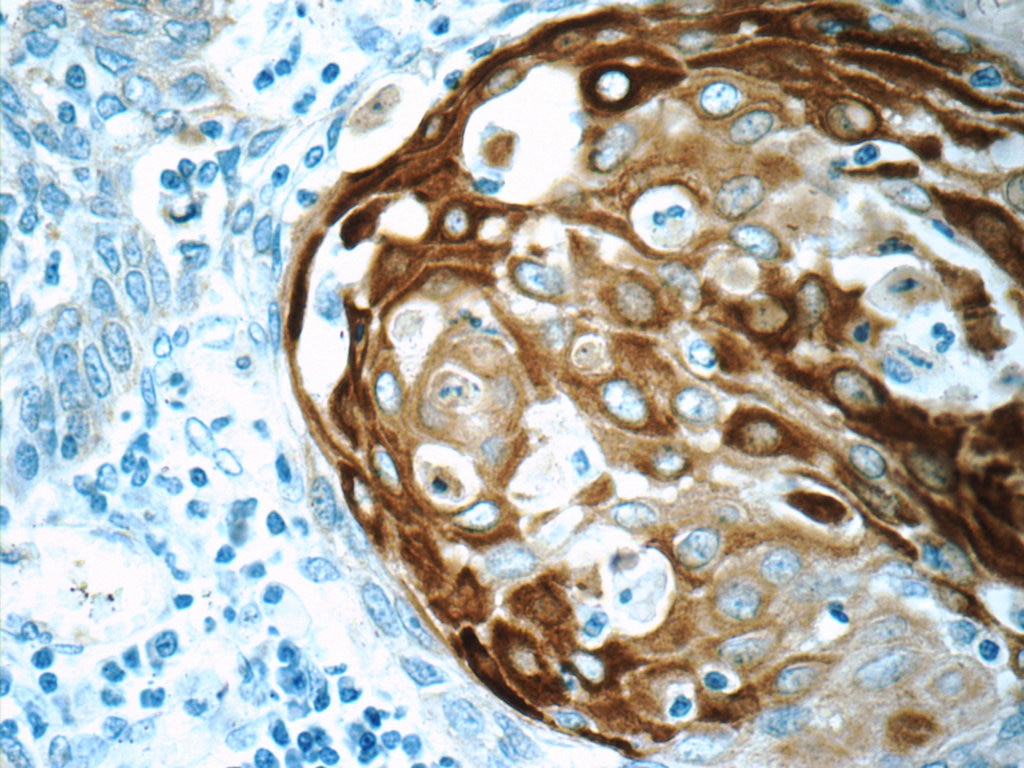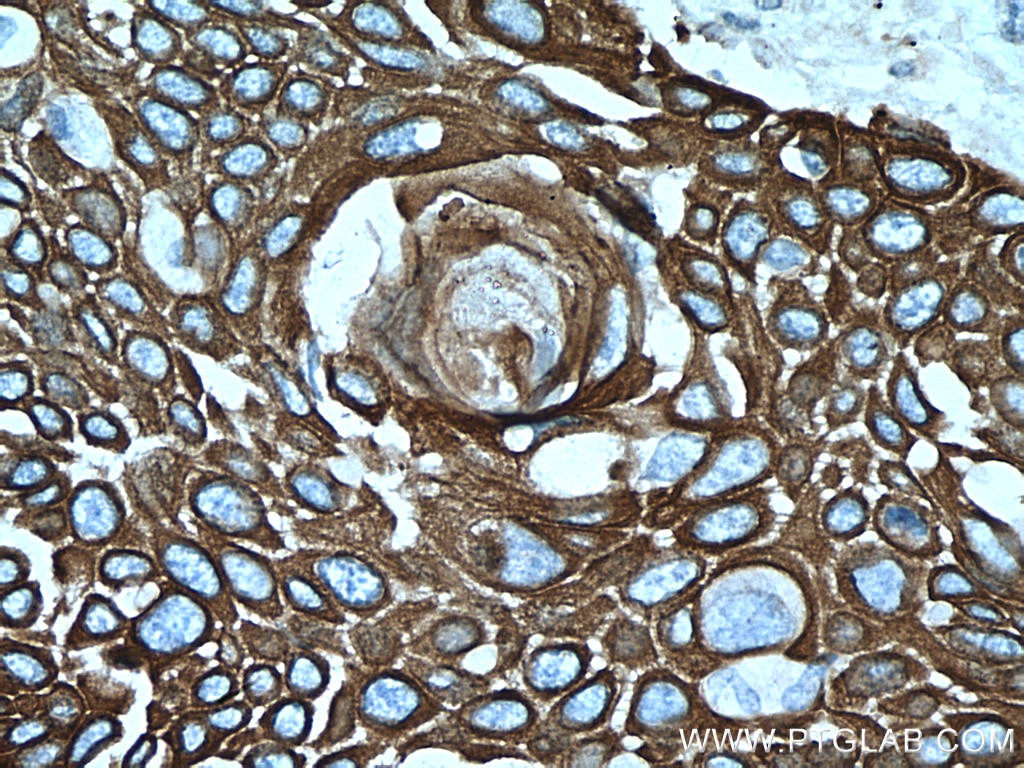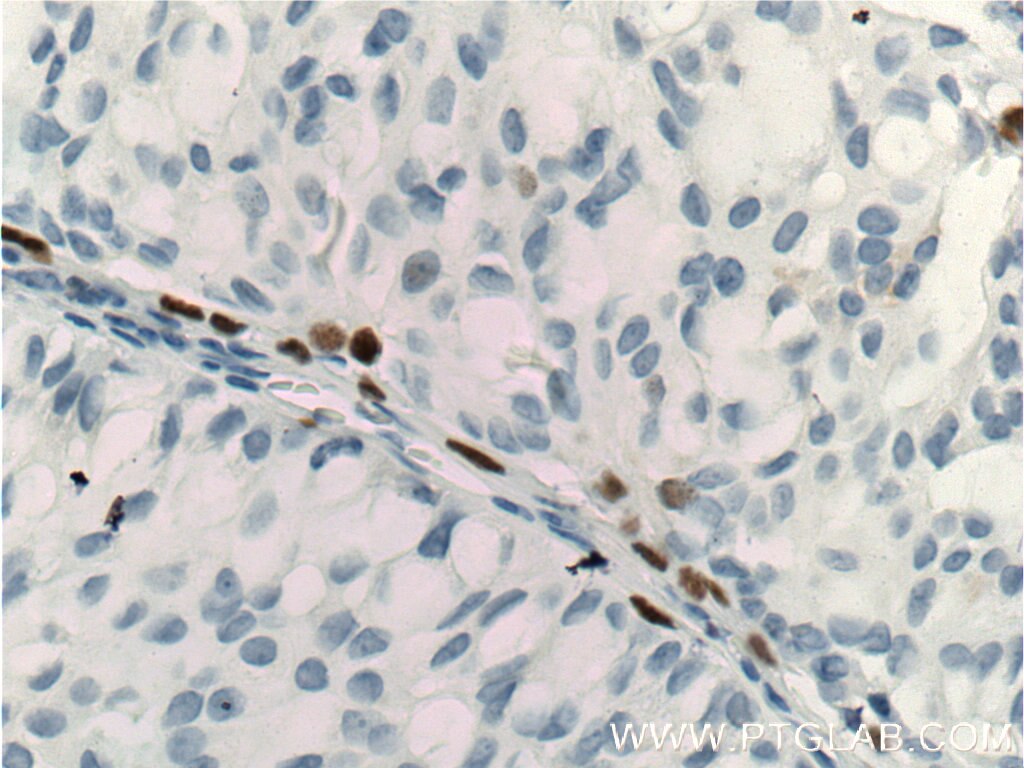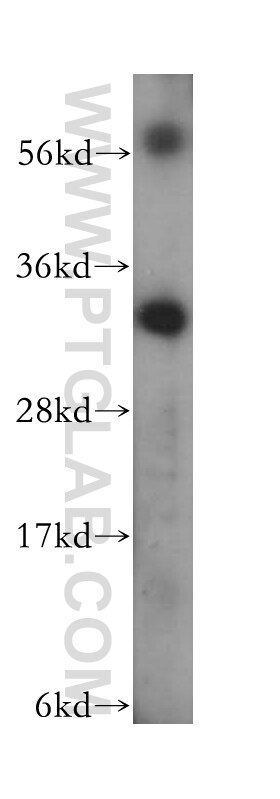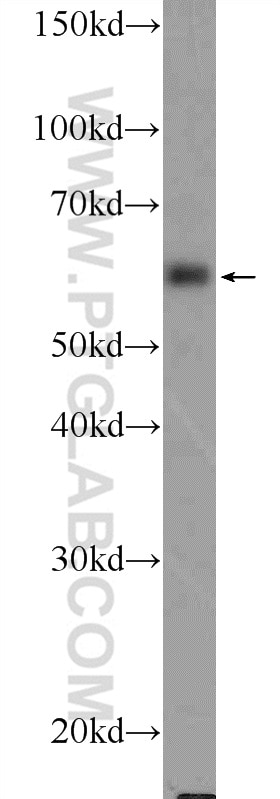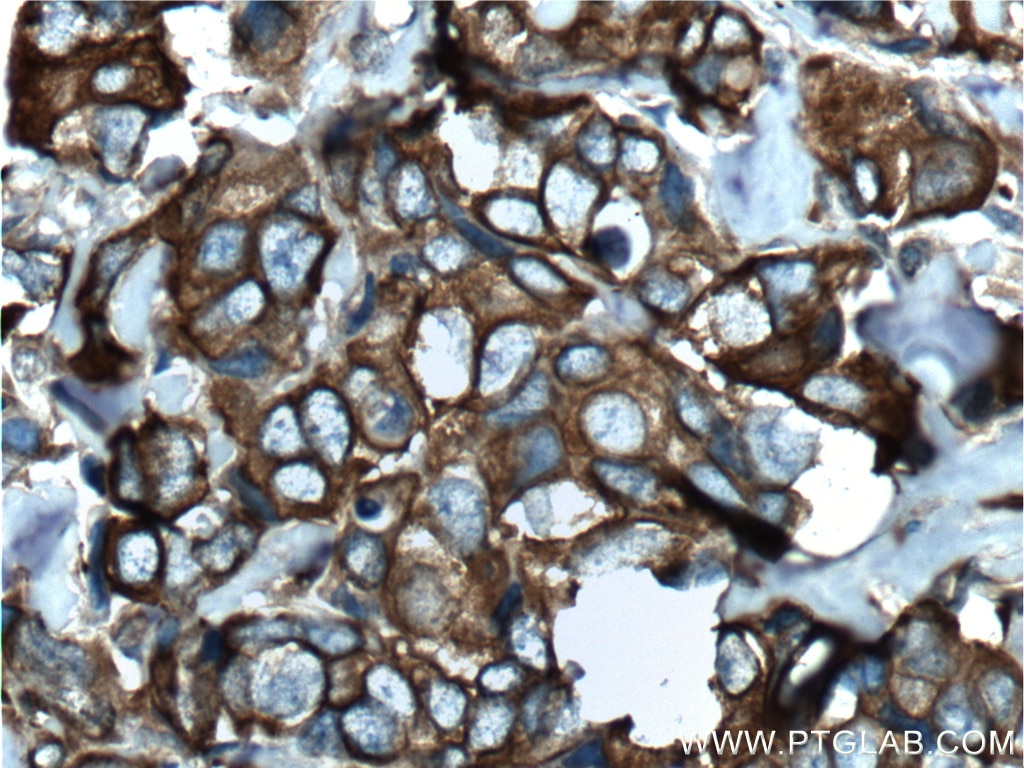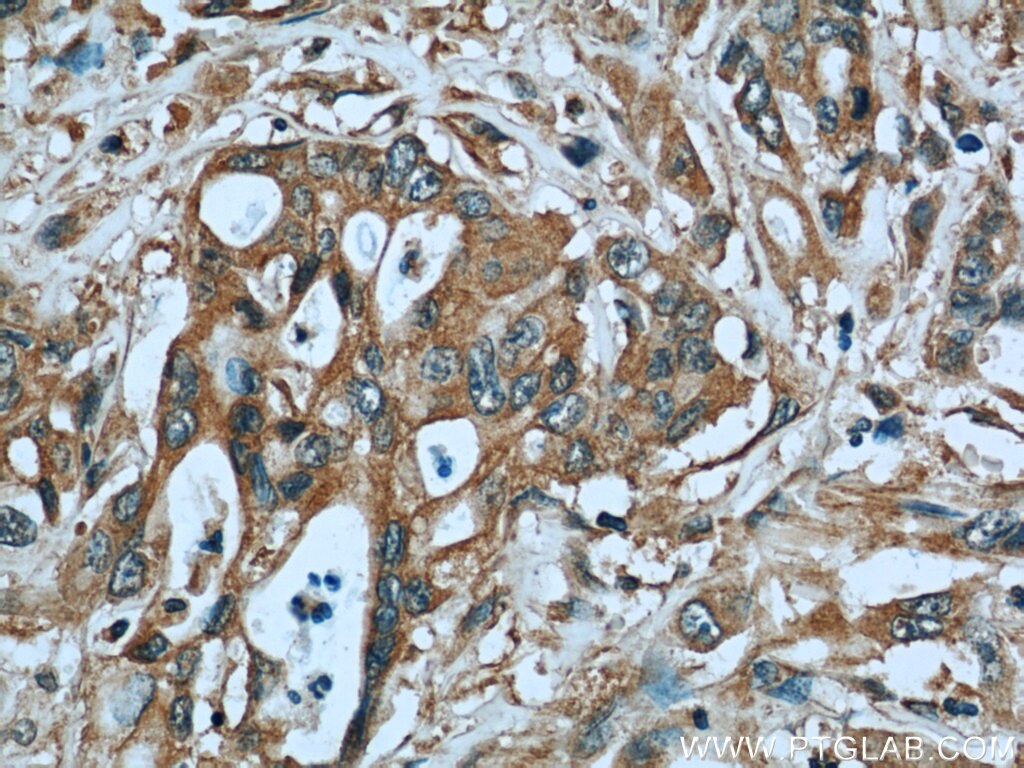- Featured Product
- KD/KO Validated
Cytokeratin 14 Polyklonaler Antikörper
Cytokeratin 14 Polyklonal Antikörper für WB, IHC, IF/ICC, FC (Intra), IP, ELISA
Wirt / Isotyp
Kaninchen / IgG
Getestete Reaktivität
human, Maus, Ratte
Anwendung
WB, IHC, IF/ICC, FC (Intra), IP, ELISA
Konjugation
Unkonjugiert
Kat-Nr. : 10143-1-AP
Synonyme
Galerie der Validierungsdaten
Geprüfte Anwendungen
| Erfolgreiche Detektion in WB | A431-Zellen, Rattenhautgewebe |
| Erfolgreiche IP | A431-Zellen |
| Erfolgreiche Detektion in IHC | humanes Lungenkarzinomgewebe, humanes Hautgewebe, humanes Hautkrebsgewebe, humanes Mammakarzinomgewebe, humanes Ösophaguskarzinomgewebe, humanes Zervixkarzinomgewebe, Maushautgewebe Hinweis: Antigendemaskierung mit TE-Puffer pH 9,0 empfohlen. (*) Wahlweise kann die Antigendemaskierung auch mit Citratpuffer pH 6,0 erfolgen. |
| Erfolgreiche Detektion in IF/ICC | HaCaT-Zellen, HeLa-Zellen, HepG2-Zellen, Maus-Riechepithelgewebe |
| Erfolgreiche Detektion in FC (Intra) | A431-Zellen |
Empfohlene Verdünnung
| Anwendung | Verdünnung |
|---|---|
| Western Blot (WB) | WB : 1:500-1:2000 |
| Immunpräzipitation (IP) | IP : 0.5-4.0 ug for 1.0-3.0 mg of total protein lysate |
| Immunhistochemie (IHC) | IHC : 1:20-1:200 |
| Immunfluoreszenz (IF)/ICC | IF/ICC : 1:200-1:800 |
| Durchflusszytometrie (FC) (INTRA) | FC (INTRA) : 0.40 ug per 10^6 cells in a 100 µl suspension |
| It is recommended that this reagent should be titrated in each testing system to obtain optimal results. | |
| Sample-dependent, check data in validation data gallery | |
Veröffentlichte Anwendungen
| KD/KO | See 1 publications below |
| WB | See 11 publications below |
| IHC | See 23 publications below |
| IF | See 42 publications below |
Produktinformation
10143-1-AP bindet in WB, IHC, IF/ICC, FC (Intra), IP, ELISA Cytokeratin 14 und zeigt Reaktivität mit human, Maus, Ratten
| Getestete Reaktivität | human, Maus, Ratte |
| In Publikationen genannte Reaktivität | human, Maus, Ratte |
| Wirt / Isotyp | Kaninchen / IgG |
| Klonalität | Polyklonal |
| Typ | Antikörper |
| Immunogen | Cytokeratin 14 fusion protein Ag0188 |
| Vollständiger Name | keratin 14 |
| Berechnetes Molekulargewicht | 472 aa, 52 kDa |
| Beobachtetes Molekulargewicht | 47-50 kDa |
| GenBank-Zugangsnummer | BC002690 |
| Gene symbol | Cytokeratin 14 |
| Gene ID (NCBI) | 3861 |
| Konjugation | Unkonjugiert |
| Form | Liquid |
| Reinigungsmethode | Antigen-Affinitätsreinigung |
| Lagerungspuffer | PBS mit 0.02% Natriumazid und 50% Glycerin pH 7.3. |
| Lagerungsbedingungen | Bei -20°C lagern. Nach dem Versand ein Jahr lang stabil Aliquotieren ist bei -20oC Lagerung nicht notwendig. 20ul Größen enthalten 0,1% BSA. |
Hintergrundinformationen
Keratins are a large family of proteins that form the intermediate filament cytoskeleton of epithelial cells, which are classified into two major sequence types. Type I keratins are a group of acidic intermediate filament proteins, including K9-K23, and the hair keratins Ha1-Ha8. Type II keratins are the basic or neutral courterparts to the acidic type I keratins, including K1-K8, and the hair keratins, Hb1-Hb6. Keratin 14 is a type I cytokeratin. It is usually found as a heterotetramer with keratin 5. Keratins K14 and K5 have long been considered to be biochemical markers of the stratified squamous epithelia, including epidermis.
Protokolle
| Produktspezifische Protokolle | |
|---|---|
| WB protocol for Cytokeratin 14 antibody 10143-1-AP | Protokoll herunterladen |
| IHC protocol for Cytokeratin 14 antibody 10143-1-AP | Protokoll herunterladen |
| IF protocol for Cytokeratin 14 antibody 10143-1-AP | Protokoll herunterladen |
| IP protocol for Cytokeratin 14 antibody 10143-1-AP | Protokoll herunterladen |
| Standard-Protokolle | |
|---|---|
| Klicken Sie hier, um unsere Standardprotokolle anzuzeigen |
Publikationen
| Species | Application | Title |
|---|---|---|
Cell Stem Cell Injury Induces Endogenous Reprogramming and Dedifferentiation of Neuronal Progenitors to Multipotency. | ||
Nat Commun Malfunction of airway basal stem cells plays a crucial role in pathophysiology of tracheobronchopathia osteoplastica. | ||
Nat Commun Human induced pluripotent stem cell-derived vocal fold mucosa mimics development and responses to smoke exposure. | ||
Biomaterials MSC-derived exosomes protect against oxidative stress-induced skin injury via adaptive regulation of the NRF2 defense system. | ||
Oncogene EB-virus latent membrane protein 1 potentiates the stemness of nasopharyngeal carcinoma via preferential activation of PI3K/AKT pathway by a positive feedback loop. | ||
Aging Cell Nociceptive transient receptor potential canonical 7 (TRPC7) mediates aging-associated tumorigenesis induced by ultraviolet B. |
Rezensionen
The reviews below have been submitted by verified Proteintech customers who received an incentive for providing their feedback.
FH Rachel (Verified Customer) (03-19-2024) | Excellent antibody, got the tester but will be purchasing more for future work.
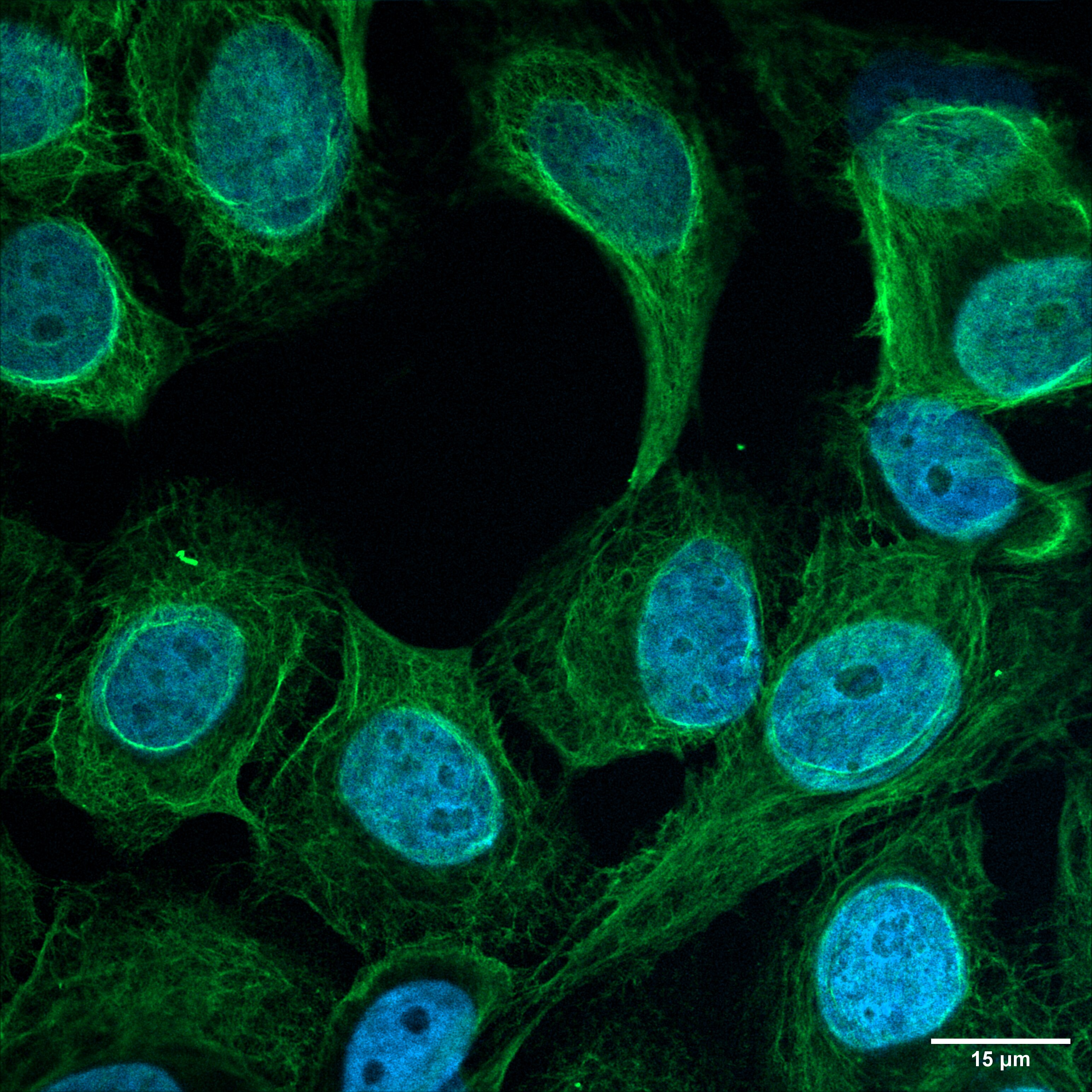 |
FH Parmveer (Verified Customer) (10-20-2019) | Worked well to detect basal cells around the prostate gland of formalin fixed tissue
 |
FH Joshua (Verified Customer) (05-10-2019) | Human Keratinocytes fixed in 4% paraformaldehyde and stained for KRT14. Goat anti-rabbit 488. Bright, specific staining observed.
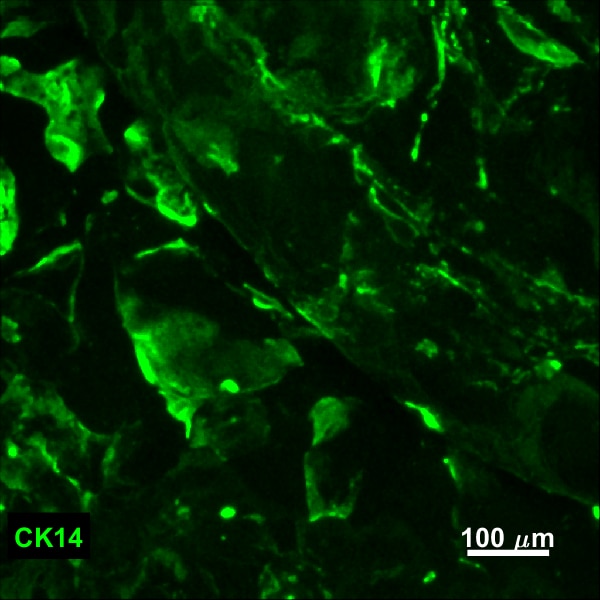 |
